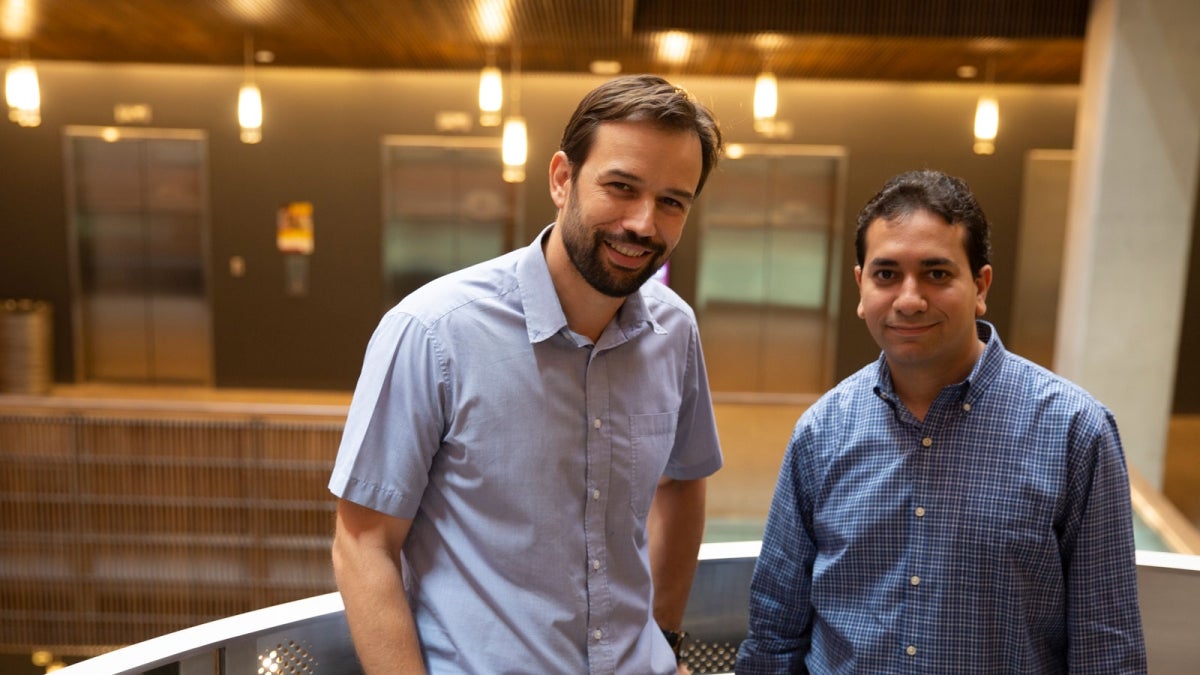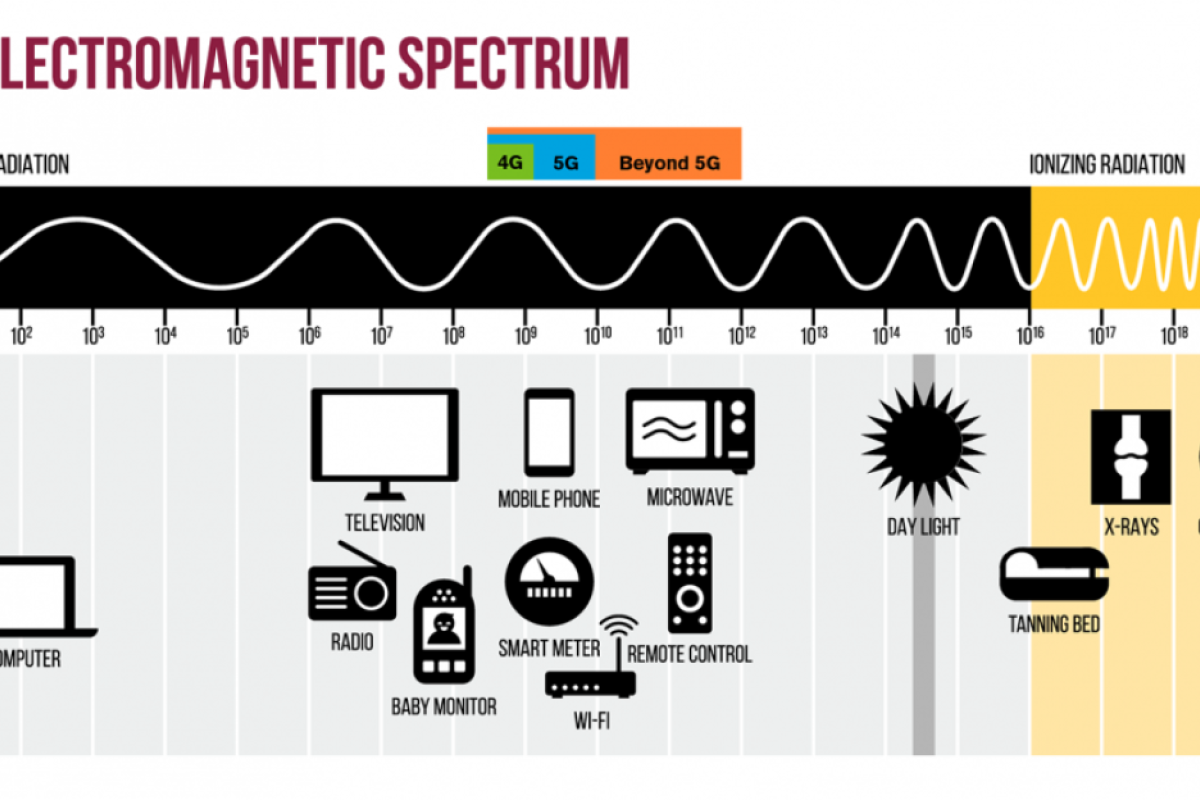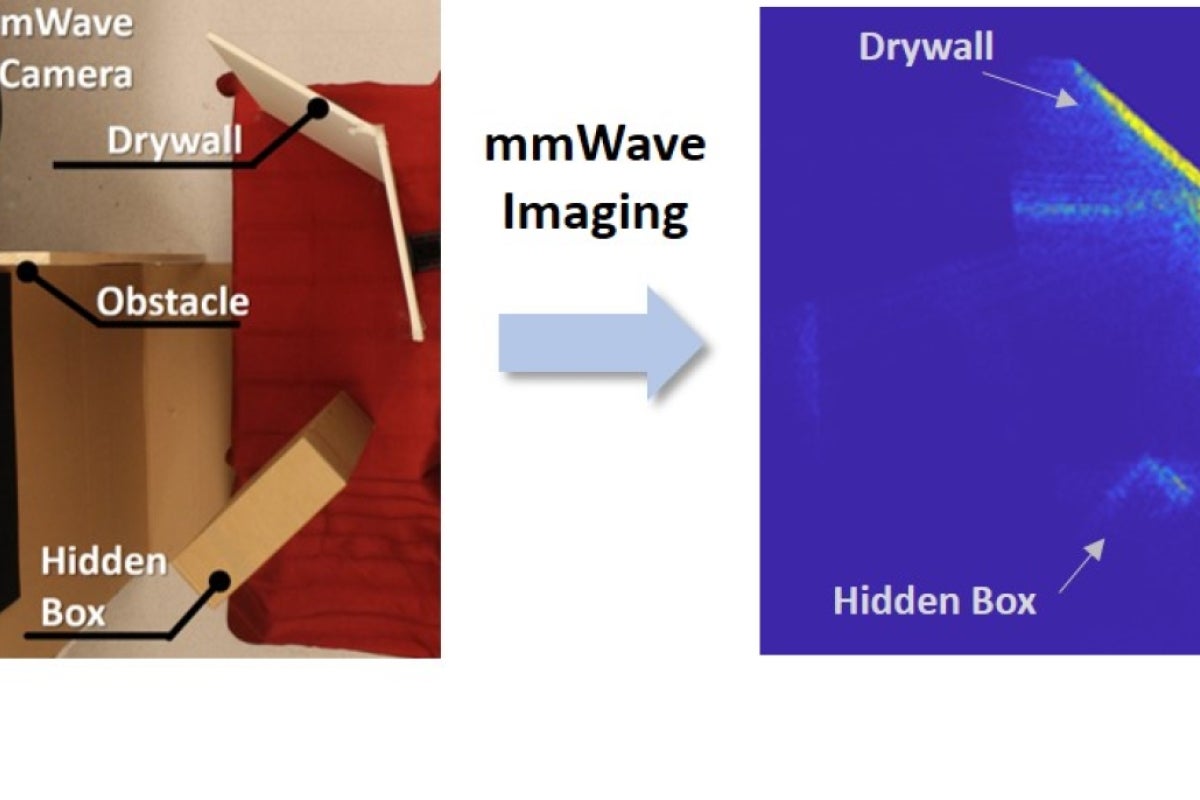6G: Building tomorrow's wireless tech beyond 100 GHz

George Trichopoulos (left) and Ahmed Alkhateeb, assistant professors of electrical engineering in the Ira A. Fulton Schools of Engineering at Arizona State University, are leading the exploration of possibilities for 6G: the sixth generation of wireless communications technology. Photo by Monique Clement/ASU
We’re quickly outpacing the abilities of the current generation of wireless communication technology, commonly known as 4G. Think about that moment you see 3G signal strength on your smartphone — you know you’re in for a slow tech experience. You may soon feel the same about 4G. And while next-generation 5G tech is only in the early stages of commercial implementation, it was nearly a decade in the making.
That’s why researchers in the Ira A. Fulton Schools of Engineering at ASU are already preparing for the implementation of 6G by 2030.
Though we typically think of current 4G technology as a mobile communications network technology, future generations of wireless technology will go beyond what we think of as communications, say George Trichopoulos and Ahmed Alkhateeb, assistant professors of electrical engineering in the Fulton Schools.
By exploring the capabilities of wireless signals in the largely unused range above 100 gigahertz — or the proposed 6G spectrum — Trichopoulos, Alkhateeb and their research collaborators think they can “enable applications outside the classical definition of communications.”
The tiny signals at this range, referred to as millimeter waves, or mmWaves, can allow for imaging, mapping, localization and higher data-rate communications to connect multiple devices and even applications that haven’t yet been invented.
Trichopoulos and Alkhateeb are among the first to generate proofs of concept to demonstrate the possibility of 6G spectrum uses and features, which were outlined in an invited paper published in research journal IEEE Access.
New wave(length), new age
Features of the 6G spectrum will make for some interesting applications and multiplicative effects.
“One plus one is more than two at 6G’s higher frequencies,” Trichopoulos said.
It all starts with higher bandwidth. Bandwidth is the maximum amount of data that can be transferred through a specific path. The current 4G wireless bandwidth is a small country road compared to the 12-lane highway capacity of 6G mmWaves. Think of how bogged down today’s wireless networks get when everyone at a stadium or large event is trying to use the internet.
Virtual reality and augmented reality applications currently suffer from a bottleneck due to low bandwidths. With higher bandwidth, VR and AR headsets could be completely wireless.
This higher bandwidth will also allow for a massive number of internet of things-connected devices (smartphones, wearables, smart appliances and more) on a single network — which is fitting since the volume of these devices is almost guaranteed to increase in the next decade. Consider how many new internet-connected devices have made their way into your home even in the last few years.
These devices could also have updated interfaces with the help of 6G’s better sensing capabilities that can “see” the world around us in ways cameras can’t.
Within a few milliseconds, a device using the 6G mmWave spectrum could use sensors to map an office, room or other complex environment. Sensing at that frequency can also detect the vibrational resonance patterns of various materials, thereby identifying objects and people in the mapped environment.
6G sensing could enable new security body scanning techniques, health monitoring, miniaturized radars and more.
Better sensing ability has the potential to enable certain applications to detect the presence of chemicals, allergens and other potential defects or other substances in the air, foods or drinks.
High-bandwidth capabilities and sensing capabilities also lead to better imaging.
Radar capabilities at 6G’s proposed frequencies have advantages over light detection and ranging, or LIDAR, which is often used for sensing in autonomous vehicles, due to the lessened impact of weather and ambient light on its abilities.
6G frequencies could also allow us to see around corners, opening up applications in rescue, surveillance, autonomous navigation and more. Above 100 GHz, walls, floors and doors typically behave like mirrors, reflecting signals to other surfaces even if they aren’t in line of sight from where the signal originated.
“This is very useful for wireless communications because mmWaves experience extreme blockage from most objects, which has a deleterious effect on the wireless links,” Trichopoulos said, describing how the 6G spectrum waves can be easily blocked, unlike 4G signals that can typically penetrate walls.
Precise positioning, also called localization, is also possible using 6G; mmWave imaging and communication can detect the position of a portable device to within a centimeter of accuracy, whether the object is in view or not. In comparison, GPS locations are accurate to within about 15 feet and mostly outdoors.
Trichopoulos and Alkhateeb are the first researchers to show proof of concept that combining imaging and communications capabilities of the 6G frequency provides localization at very high accuracy, and it can be used to see objects out of line of sight
The better mapping and localization is key to what engineers call simultaneous localization and mapping, or SLAM, which is useful for autonomous driving, robotics applications, VR and AR.
Hard(ware) to pin down
Many of these capabilities rely on improvements to the hardware that will enable 6G wireless communications network technology.
“The big unknown is the hardware,” Trichopoulos said. “We don’t yet have powerful sources of mmWave signals and sensitive receivers that operate (at 6G frequencies) and are cost-effective and energy-efficient.”
One drawback to the tiny wavelength of 6G frequencies is that it can be easily interrupted and weakens after a short distance. But hardware improvements in the form of new antenna arrays can make up for 6G’s shortcomings.
Trichopoulos’ research team at ASU is developing some of the hardware advances needed to support 6G devices, including large antenna arrays. In this case, "large" actually means small and refers to that large number — hundreds to thousands — of tiny antennas small enough to fit on a chip the size of a postage stamp.
But hardware alone can’t enable all 6G’s features.
“Machine learning and artificial intelligence will play an important role in 6G and future generations,” Alkhateeb said.
Artificial intelligence and machine learning algorithms, which teach computers to do tasks on their own, need to be developed to handle 6G’s new capabilities of sensing, mapping, imaging, localization and efficient communications.
Outlining 6G’s possibilities is the first baby step in what is likely to be a decade-long journey to implementation. But it’s a worthwhile one considering all the things wireless communications technology could accomplish in the future.
Collaborating on a high-frequency future
Alkhateeb and Trichopoulos leverage expertise from other wireless technology researchers to uncover the potential capabilities of the proposed 6G frequency.
Theodore S. Rappaport, the David Lee/Ernst Weber Professor at New York University, pioneered many aspects of wireless communications technology and Wi-Fi standards, while three of his doctoral students contributed to preliminary research into 6G applications. Yunchou Xing’s research focuses on 5G mmWave wireless, Ojas Kanhere conducts research on mmWave localization and channel modeling and Shihao Ju researches mmWave and Terahertz channel technologies.
Arjuna Madanayake, associate professor of electrical and computer engineering at Florida International University, contributed to the circuitry, signal processing and antenna research.
Soumyajit Mandal, T. and A. Schroeder Assistant Professor of electrical engineering and computer science at Case Western Reserve University in Cleveland, Ohio, whose research interests include analog and biological computation and sensor interface applications, also helped the research team with hardware considerations for future 6G technologies.
More Science and technology

ASU researchers engineer product that minimizes pavement damage in extreme weather
Arizona State University researchers have developed a product that prevents asphalt from softening in extreme heat and becoming…

New study finds the American dream is dying in big cities
Cities have long been celebrated as places of economic growth and social mobility, but new research suggests that their role in…

Ancient sea creatures offer fresh insights into cancer
Sponges are among the oldest animals on Earth, dating back at least 600 million years. Comprising thousands of species, some with…











